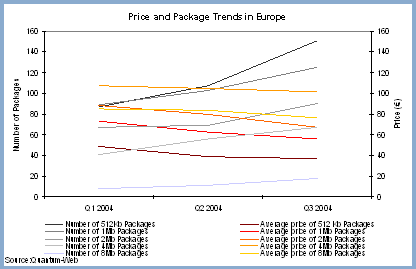This is the first in a series of eight articles with some of the people involved with the Digital Lifestyles conference day at IBC2004.
We interviewed Simon Perry, the executive producer of the Digital Lifestyles theme day, in a two-part feature that covers on the makeup of the day and question him convergence and other aspects of the media. He publishes Digital Lifestyles magazine.
Fraser Lovatt: Tell me about the four discussion sessions at IBC this year. What are they about and who’s speaking at them?Simon Perry: When the Digital Lifestyles day was introduced at IBC last year, my aim was to set the scene – to signal the change in the content industry. This year builds on that, by highlighting four specific areas that merit closer attention by the creative, business and technology people.
The day will inform the delegates on the new types of content possible, how to get paid for it, where you can deliver it and the business models around it.
The first session is titled ‘New platforms, new content’.
It is set in the context that, with new content delivery methods comes new forms of content. It’s chaired by Ashley Highfield, director of New Media & Technology at the BBC, and will create a discussion between some of the most experienced and forward-thinking Games, Film and TV people. In each of their fields they are bringing together different strands of content, creating something that couldn’t have existed previously, such as content that migrates between platforms, creating united content.
The second session is about getting paid for content. Up to now, the industry has been focused on protecting the content that they have, which is understandable and technology companies have been more than happy to assist them.
I feel this is a distraction. The really key part is how the consuming public are going to pay for content that they think is worth paying for, whether they receive it to their mobile phone, their TV, via broadband to their PC’s or through an adaptor on to their TV. The methods of payment are as diverse as the delivery methods.
The panel brings together the knowledge and experience of people who are successfully receiving payments from the public for text and video content; others offering payment systems that take small amounts, less that a pound/dollar, online and others that use mobile phones to make payments.
Tim Jones, the CEO of Simpay will be on the panel. Simpay was brought to life by the four major mobile phone networks in the UK. The first stage of their service offers the phone-carrying public to pay for phone delivered content – catching up with the currently favoured premium-rate SMS charging. The next stage is – and this is where it becomes a more interesting example – allowing you pay for any types of content, as well as physical goods from shops, using your phone. It is something that has been theorised for a long time and Simpay appear to be pulling it together now. Tim’s background is particularly interesting. He co-invented Mondex, which as we all know, was the first form of public e-cash in the UK.
The third session is chaired by Ken Rutkowski of Ken Radio, and is about informing the content creators about the increasing range of platforms that are available to them for distributing their content. Within the industry there are different stages of knowledge, expectation and experience of what digital lifestyles will mean to the creators of the content, as well as the public. In this third session they will explore what roles different media play on different platforms and the effect it is going to have on the type of content people produce. Ken’s enthusiasm will lift the best out of the panellist.
The forth session is future business models chaired by media journalist, Kate Bulkley. It will explore the models that will run aside 30-second spot ads; mobile delivery; gaining benefit from efficient delivery to different platforms; generating new revenue from TV. There’s a lot of innovation in this area.
What does convergence mean to you? What’s your internal definition of it?
It’s an interesting word. It’s been around for a long time – and increasingly, over the last six/nine months it has become to mean anything that any marketeer wants it to mean. The original definition saw all devices being morphed in to one device. It’s clear that there won’t be convergence to that extent. It’s becoming less defined. The more it enters everyones vocabulary, the wider the definition becomes. Perversely it’s definition is diverging.
The convergence that Digital Lifestyles magazine focuses on, is how the influx of technology into the creation, transfer and reception of media content is changing the industry. Where media and technology touch, is what’s of interest to us, and the impact it will have.
There is an argument that media has always been a technological activity. From first workings and marking things on cave walls to the development of perspective, to the first film studios to television. It has always been technology-led.
That is probably true. Well it’s not probably true – it is true. The definition of what is technology is a sliding window, isn’t it? Pens, paper and the printing press were all once thought of as advanced technology, and then they slowly shifted to become the norm. I would argue that the window moves more quickly these days.
But media always seems to be at the forefront of technology – many technological breakthroughs are media related and have been throughout the history of mankind.
Technology has certainly had an influence – I don’t know whether media has always been pushing technology, or whether it has always been using the latest technology. It certainly has previously utilised it, and the people who have utilised the technology are the ones that have had the upper hand. Look back to Murdoch in the use of technology in the production of newspapers, originally pioneered by the Eddie Shah with Today.
I think people get business advantage by using technology and media. I don’t think necessarily the mainstream media are quick in adopting technologies and making the most of them, and that’s frustrating. However, this gives a space for the people who are outside the mainstream media, micro-production companies if you will, to use the technologies to create and deliver their content to an audience on an economic basis.
Do you think the public thave an active participation in convergence? Do they see the convergence as something they are getting involved in or do they see it as something that has happened around them? Five years ago they were going out and buying DVD players and now they are buying PVRs – Do you think they are seeing it as progress or just something new to buy?
Let’s use digital music, because that’s quite a good example. One of the articles on Digital Lifestyles today covered the Virgin Music Player, a little thing you just hang on your waist. People will obviously notice that they don’t have to carry around a bulky CD player or a mini disc player or a cassette player, but as to whether they realise that the changes are wider reaching than that – I doubt it. It will feel like another small step.
These days people are now conscious of change. They have come to expect things to change. They are becoming numbed to the “Oh my god” reaction, when they come into contact with a new use of technology.
The people in the industry see it as significant, because they see the long-term impact.
One of the ironies I perceive with convergence is that the media itself, those pieces of entertainment like music, film and to some extent e-books, are becoming fragmented through platform and DRM issues. Do you think that we will be happy buying three versions of the same thing in the near future because the DRM or file formats are incompatible, or do you think that this will be resolved gracefully?
Incompatibility is a fear of mine and yes, in the short term, it is likely. It’ll happen because of the number of incompatible content protection systems that are around. I think the industry, whether it be the providers of content protection or the media companies, which are using the content protection systems that don’t allow interchange between devices are going to do themselves a disservice and, if it continues, will frankly end up irritating the customer.
I have asked the question to quite a number of people in the media business and technology business – I have never really had a good answer from them either. How do you sell the public something that’s less good, through it’s restrictions, than the thing that is being replaced? Something that ends up flexible, even though the form it is held in allows greater flexibility? So, short term I think it probably will be a problem. I hope that it won’t be a problem beyond the short term.
It can be argued that a lot of the fragmentation that we are seeing in media in file formats and devices is down to proprietary systems that are involved in the creation of media, and in its protection and distribution so we have DRM, we have CDs which can’t be played on PCs. These are all proprietary. Do you think there is a place for open standards in a convergent media culture?
I think the reason this hasn’t happened so far is that the prize is so enormous. The prize for being the provider of content protection is to be one of the largest businesses in the world. Much commercial material will only reside in the rights holders-approved DRM formats; ones that they feel protect their interest. That’s not to say that there won’t be a huge market for other content in another format, and that could be an open format.
Do you think that one company will be allowed to hold the keys for content protection?
Who is going to stop them? Are you talking about Government restrictions?
Some view it as a monopoly.
Certainly from the discussions I have had with content creators of the large studios, there is an unease with a number of companies holding all of the keys. There have been many suggestions as to the way that could be got around. One I found interesting was Fraunhoffer’s Light Weight DRM (LWDRM), but it still relies on a central repository that decides whether you are entitled to this music or that you have paid to have access to it.
The Fraunhoffer response to that question is to say, well we place that with a third party – so you split up the business of running the content protection system away from the business of holding the keys to the access to that content. Their suggestion was that it be done by institutions like the German post office. Different nations have got different relationships with their governments. So that’s something that might work in a country such as Germany, but not others.
There are two arguments – on the open source side there are many people, the Electronic Frontier Foundation (EFF) for example, who argue that there should be no content protection and people will pay for their content, relying on the good nature of man.
Rightly or wrongly, that is not how the mainstream media industry sees it. But if you look at companies like Warp Records, they sell their music in MP3 format. They have taken a more open file format, which can be exchanged quickly between different formats and difference devices. The consumer in me sees this as completely reasonable. I buy something and then I am able to put it on whichever device I want.
I did some research for the European Commission on a unified media platform called N2MC and it became clear from speaking to a wide range of people, along the whole creation-to-distribution change, that the idea of an open source content protection system didn’t currently work for them.
Because it could be easily reversed engineered?
It was seen as a weakness in the chain. One part of a content protection system must remain proprietary.
This interview is continued and concluded here.
Simon is chairing ‘The missing piece – Getting paid for content’ session between 11:30 and 13:00 at the IBC conference on Sunday, 12th September in Amsterdam. Register for IBC here
 Last weekend there was a report that France Telecom (FT) were rumored to be buying Cable and Wireless (C&W) for GBP 4bn. FT has of course denied it.
Last weekend there was a report that France Telecom (FT) were rumored to be buying Cable and Wireless (C&W) for GBP 4bn. FT has of course denied it. One area where they have invested in and have made real progress is Local Loop Unbundling (LLU) with their purchase of Bulldog (for GBP 18m). Bulldog have now unbundled about 400 exchanges and have plans to unbundle another 400 by the end of the year.
One area where they have invested in and have made real progress is Local Loop Unbundling (LLU) with their purchase of Bulldog (for GBP 18m). Bulldog have now unbundled about 400 exchanges and have plans to unbundle another 400 by the end of the year. Wanadoo (the ISP arm of FT) has stated they are going to invest EU 300m in unbundling exchanges (in the first year) and rumour has it there’s a total of EU 1bn over 3 years for LLU. So FT could buy C&W just for the LLU aspects, but really does seem excessive. C&W bought Bulldog for GBP 18m and they’ve invested at least 10’s of million into them. So 4bn is a HUGE premium to pay for a ready made network and 10’s of thousands of customers. Wanadoo already have considerably more broadband customers than Bulldog.
Wanadoo (the ISP arm of FT) has stated they are going to invest EU 300m in unbundling exchanges (in the first year) and rumour has it there’s a total of EU 1bn over 3 years for LLU. So FT could buy C&W just for the LLU aspects, but really does seem excessive. C&W bought Bulldog for GBP 18m and they’ve invested at least 10’s of million into them. So 4bn is a HUGE premium to pay for a ready made network and 10’s of thousands of customers. Wanadoo already have considerably more broadband customers than Bulldog. A report by compilers Mintel International has revealed that pets are being ousted by consumer electronics in British homes.
A report by compilers Mintel International has revealed that pets are being ousted by consumer electronics in British homes. The study observed that, “In those families with children, the demand for pets may not be as strong as it once was, since many children now prefer to immerse themselves in the world of computer games and TV programmes”.
The study observed that, “In those families with children, the demand for pets may not be as strong as it once was, since many children now prefer to immerse themselves in the world of computer games and TV programmes”. But it’s not all bad news for our precious pampered pooches and treasured tabbies, with the report revealing that sales of pet food, accessories and pet insurance have rocketed by 24 percent in the past five years, reaching a total of US$6.5 billion.
But it’s not all bad news for our precious pampered pooches and treasured tabbies, with the report revealing that sales of pet food, accessories and pet insurance have rocketed by 24 percent in the past five years, reaching a total of US$6.5 billion. With the rise of home entertainment robots like the Sony Aibo and the forthcoming Nintendo virtual pet game, Nintendogs (where virtual dogs will respond to voice commands and bark at passing Nintendog consoles), we wonder how long it will be before children think that pets live on batteries.
With the rise of home entertainment robots like the Sony Aibo and the forthcoming Nintendo virtual pet game, Nintendogs (where virtual dogs will respond to voice commands and bark at passing Nintendog consoles), we wonder how long it will be before children think that pets live on batteries. Last week, 250 executives from advertising agencies, game developers and publishers swarmed into the first annual Advertising in Games Forum on 14 April 2005 in New York City.
Last week, 250 executives from advertising agencies, game developers and publishers swarmed into the first annual Advertising in Games Forum on 14 April 2005 in New York City. For the benefit of buzzword-deficient execs, Yankee Group senior analyst Mike Goodman explained that this hideous word describes what you get when advertisers create a game around a product rather than place their brands within a well-known title.
For the benefit of buzzword-deficient execs, Yankee Group senior analyst Mike Goodman explained that this hideous word describes what you get when advertisers create a game around a product rather than place their brands within a well-known title. Fact-bloated attendees also learned that the top selling 2004 game titles (according to the NPD Group) were:
Fact-bloated attendees also learned that the top selling 2004 game titles (according to the NPD Group) were: